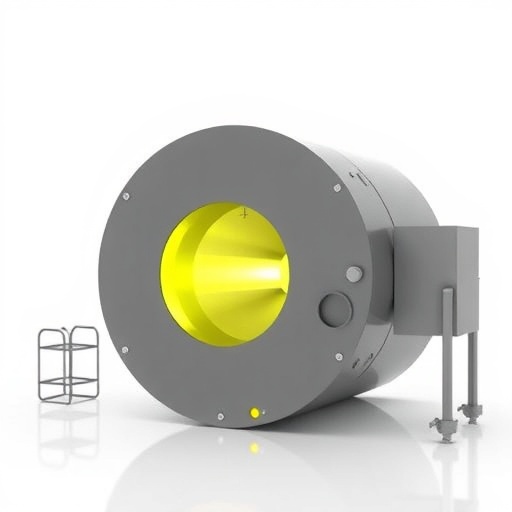In a groundbreaking advancement for cancer treatment, researchers have demonstrated the feasibility of a novel technique known as range-compensated pencil beam scanning proton Arc therapy. This innovative form of proton radiation therapy promises to enhance the precision and effectiveness of tumor targeting while minimizing damage to surrounding healthy tissues, marking a significant milestone in the ongoing evolution of radiotherapeutic modalities.
Proton therapy has long been heralded for its superior dose distribution characteristics compared to conventional X-ray radiation therapy. The physical properties of protons, particularly the Bragg peak phenomenon, allow for energy deposition focused intensely within the tumor volume, sparing adjacent normal tissues. However, traditional proton delivery methods face challenges related to treatment robustness, complexity, and the dynamic motion of tumors during therapy sessions. The development of pencil beam scanning (PBS), which moves narrow proton beams across the tumor field, has addressed some of these concerns, yet further improvements were necessary to overcome residual limitations.
The research team’s introduction of a range-compensated PBS Arc therapy approach harnesses the synergy between advanced treatment planning and the mechanical capabilities of modern proton delivery systems. By delivering proton beams in a continuous arc around the patient, the technique improves dose conformity and reduces entrance dose exposure, further sparing non-target tissues. Such continuous arc delivery mirrors the principles of volumetric modulated arc therapy (VMAT) used in photon radiation but is adapted to the distinct physical behavior of protons.
.adsslot_4x8otmcwhF{ width:728px !important; height:90px !important; }
@media (max-width:1199px) { .adsslot_4x8otmcwhF{ width:468px !important; height:60px !important; } }
@media (max-width:767px) { .adsslot_4x8otmcwhF{ width:320px !important; height:50px !important; } }
ADVERTISEMENT
Key to the success of this method is the integration of range compensators, which are devices or algorithms that adjust the proton beam’s penetration depth to conform to the complex three-dimensional shape of tumors. This range compensation counteracts variations in tissue density and geometry, enhancing the accuracy of dose delivery. The researchers have meticulously developed algorithms that optimize range compensation dynamically during arc delivery, a feat that addresses one of the longstanding technical hurdles in proton arc therapy implementation.
Their feasibility study involves sophisticated treatment planning simulations complemented by preliminary dosimetric evaluations. Using patient data and anatomically realistic phantoms, the team compared the range-compensated PBS Arc therapy to conventional PBS plans. The results revealed marked improvements in dose homogeneity within the tumor volume and notable reductions in doses to critical structures. Particularly in anatomically challenging sites such as head and neck or thoracic tumors, this method displayed superior robustness to uncertainties arising from patient movement and proton range fluctuations.
Such improvements bear profound clinical implications. By refining the focal delivery of proton therapy, the novel arc-based approach holds potential to reduce acute and long-term radiation-induced side effects, which are key determinants of patient quality of life post-treatment. Moreover, enhanced dose conformity offers opportunities to escalate tumor doses safely, possibly improving local control rates for radioresistant cancers. The ability to adapt treatment dynamically during delivery could further revolutionize patient-specific treatment customization.
Technologically, implementing range-compensated PBS Arc therapy necessitates modern proton therapy hardware capable of precise beam modulation and rapid gantry rotation. The study discusses the integration of existing pencil beam scanning proton therapy systems with software innovations that enable synchronous control of beam energy, intensity, and spatial orientation throughout the arc. Challenges such as beam-on timing, mechanical accuracy, and interplay effects between the moving beam and patient anatomy were addressed with advanced optimization workflows and real-time monitoring strategies.
Importantly, the researchers emphasize that their findings underscore feasibility rather than immediate clinical application. Extensive experimental validation, clinical trials, and regulatory assessments remain essential before widespread adoption. Nonetheless, this study charts a clear roadmap for the next phase of proton therapy evolution, bridging theoretical promise with practical deliverability.
From a broader perspective, the adoption of proton Arc therapy aligns with precision medicine’s objectives, wherein treatments are increasingly tailored to individual patients’ unique tumor biology and anatomy. In conjunction with imaging modalities such as four-dimensional computed tomography (4DCT) and magnetic resonance imaging (MRI), this approach can enable adaptive radiotherapy protocols responsive to anatomical changes over the treatment course.
Furthermore, the technique may synergize with emerging modalities like immunotherapy, potentially enhancing radiosensitivity of tumors and improving systemic therapeutic outcomes. The reduced radiation exposure to normal tissues also opens avenues for multimodal treatment regimens with lower cumulative toxicity.
The research also addresses concerns over treatment duration and throughput in busy proton therapy centers. By optimizing dose delivery efficiency through arc scanning, sessions may become shorter relative to conventional spot scanning methods, improving patient comfort and increasing facility utilization. Additionally, the flexibility of intensity modulation throughout the arc provides better sparing of critical organs at risk, a paramount consideration in pediatric oncology and reirradiation settings.
As the global proton therapy landscape expands, with increasing numbers of centers worldwide, innovations such as range-compensated PBS Arc therapy will be vital to justify the substantial infrastructure investments by delivering superior clinical outcomes. Early adoption in complex multi-institutional trials could accelerate evidence generation and refine the technology further.
In conclusion, this feasibility study unveils a sophisticated and promising advancement in proton radiation therapy by combining arc-based proton delivery with dynamic range compensation. The approach builds on the known advantages of proton therapy, enhancing the precision, robustness, and efficiency of tumor dose delivery. While technical and clinical challenges remain to be addressed, this work lays the foundation for a new generation of adaptive, patient-focused proton treatment paradigms. As efforts continue to translate these promising results into clinical realities, the future of radiotherapy may witness a transformative leap, offering hope for improved cancer control with fewer side effects.
Subject of Research:
The feasibility and dosimetric evaluation of range-compensated pencil beam scanning proton Arc therapy for improved cancer treatment.
Article Title:
Range-compensated pencil beam scanning proton Arc therapy: a feasibility study.
Article References:
Smith, B.R., Flynn, R.T., Gutiérrez, A.N. et al. Range-compensated pencil beam scanning proton Arc therapy: a feasibility study. Commun Eng 4, 139 (2025). https://doi.org/10.1038/s44172-025-00460-z
Image Credits: AI Generated
Tags: Bragg peak phenomenon in proton therapydynamic tumor motion managementenhancing dose conformity in radiation therapyinnovative cancer treatment modalitiesminimizing damage to healthy tissuespencil beam scanning proton therapyprecision cancer treatmentproton radiation therapy advancementsproton therapy delivery systemsproton therapy treatment planningrange-compensated proton therapytumor targeting techniques






